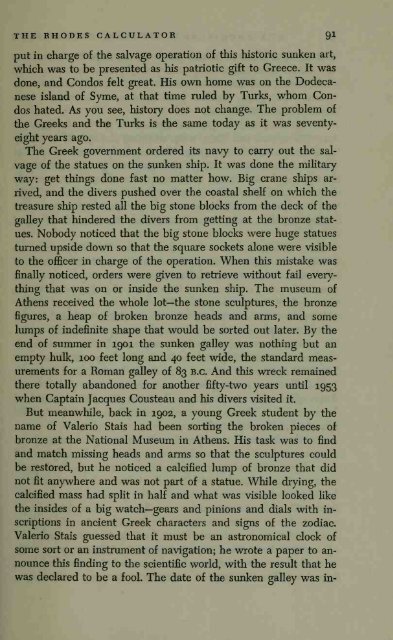Create successful ePaper yourself
Turn your PDF publications into a flip-book with our unique Google optimized e-Paper software.
THE RHODES CALCULATOR<br />
Ql<br />
put in charge of the salvage operation of this historic sunken art,<br />
which was to be presented as his patriotic gift to Greece. It was<br />
done, and Condos felt great. His own home was on the Dodecanese<br />
island of Syme, at that time ruled by Turks, whom Condos<br />
hated. As you see, history does not change. The problem of<br />
the Greeks and the Turks is the same today as it was seventyeight<br />
years ago.<br />
The Greek government ordered its navy to carry out the salvage<br />
of the statues on the sunken ship. It was done the military<br />
way: get things done fast no matter how. Big crane ships arrived,<br />
and the divers pushed over the coastal shelf on which the<br />
treasure ship rested all the big stone blocks from the deck of the<br />
galley that hindered the divers from getting at the bronze statues.<br />
Nobody noticed that the big stone blocks were huge statues<br />
turned upside down so that the square sockets alone were visible<br />
to the officer in charge of the operation. When this mistake was<br />
finally noticed, orders were given to retrieve without fail<br />
everything<br />
that was on or inside the sunken ship. The museum of<br />
Athens received the whole lot—the stone sculptures, the bronze<br />
figures, a heap of broken bronze heads and arms, and some<br />
lumps of indefinite shape that would be sorted out later. By the<br />
end of summer in 1901 the sunken galley was nothing but an<br />
empty hulk, 100 feet long and 40 feet wide, the standard measurements<br />
for a Roman galley of 83 b.c. And this wreck remained<br />
there totally abandoned for another fifty-two years until 1953<br />
when Captain Jacques Cousteau and his divers visited it.<br />
But meanwhile, back in 1902, a young Greek student by the<br />
name of Valerio Stais had been sorting the broken pieces of<br />
bronze at the National Museum in Athens. His task was to find<br />
and match missing heads and arms so that the sculptures could<br />
be restored, but he noticed a calcified lump of bronze that did<br />
not fit anywhere and was not part of a statue. While drying, the<br />
calcified mass had split in half and what was visible looked like<br />
the insides of a big watch—gears and pinions and dials with inscriptions<br />
in ancient Greek characters and signs of the zodiac.<br />
Valerio Stais guessed that it must be an astronomical clock of<br />
some sort or an instrument of navigation; he wrote a paper to announce<br />
this finding to the scientific world, with the result that he<br />
was declared to be a fool. The date of the sunken galley was in-

















